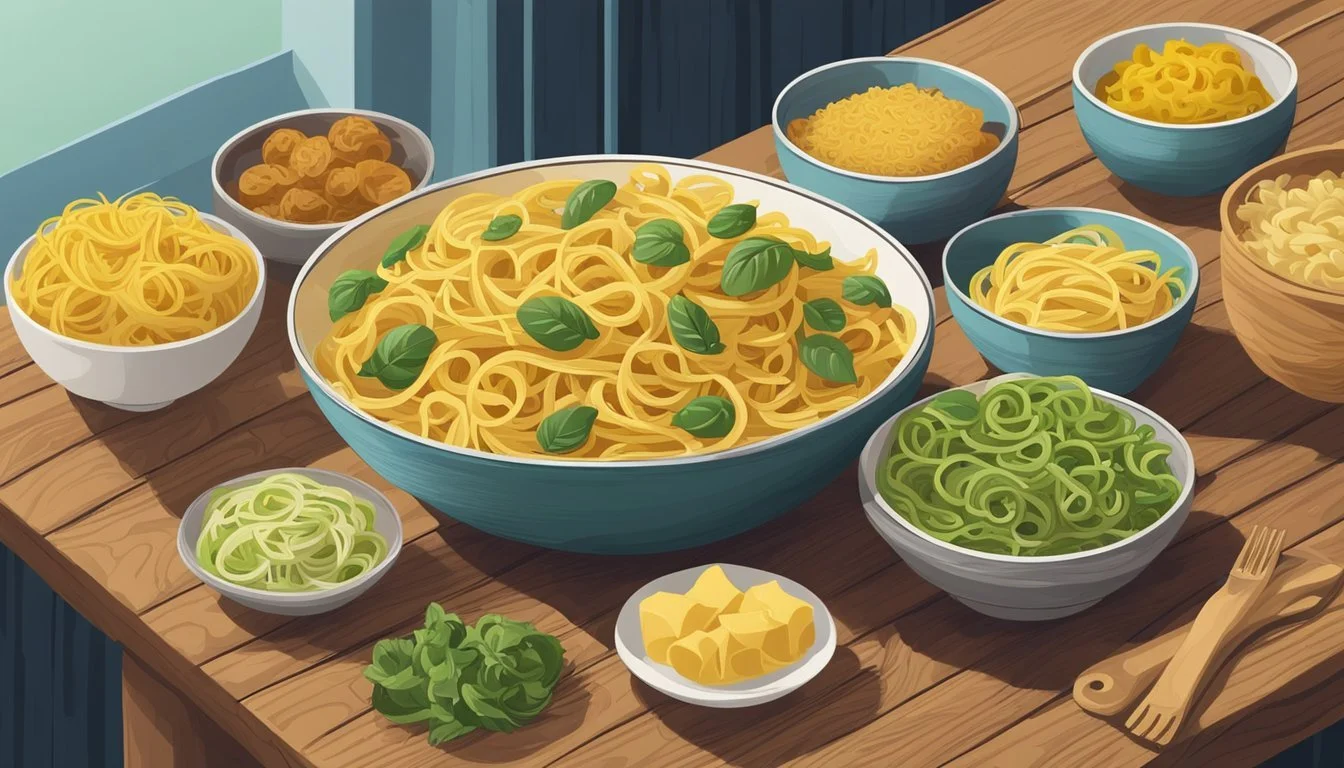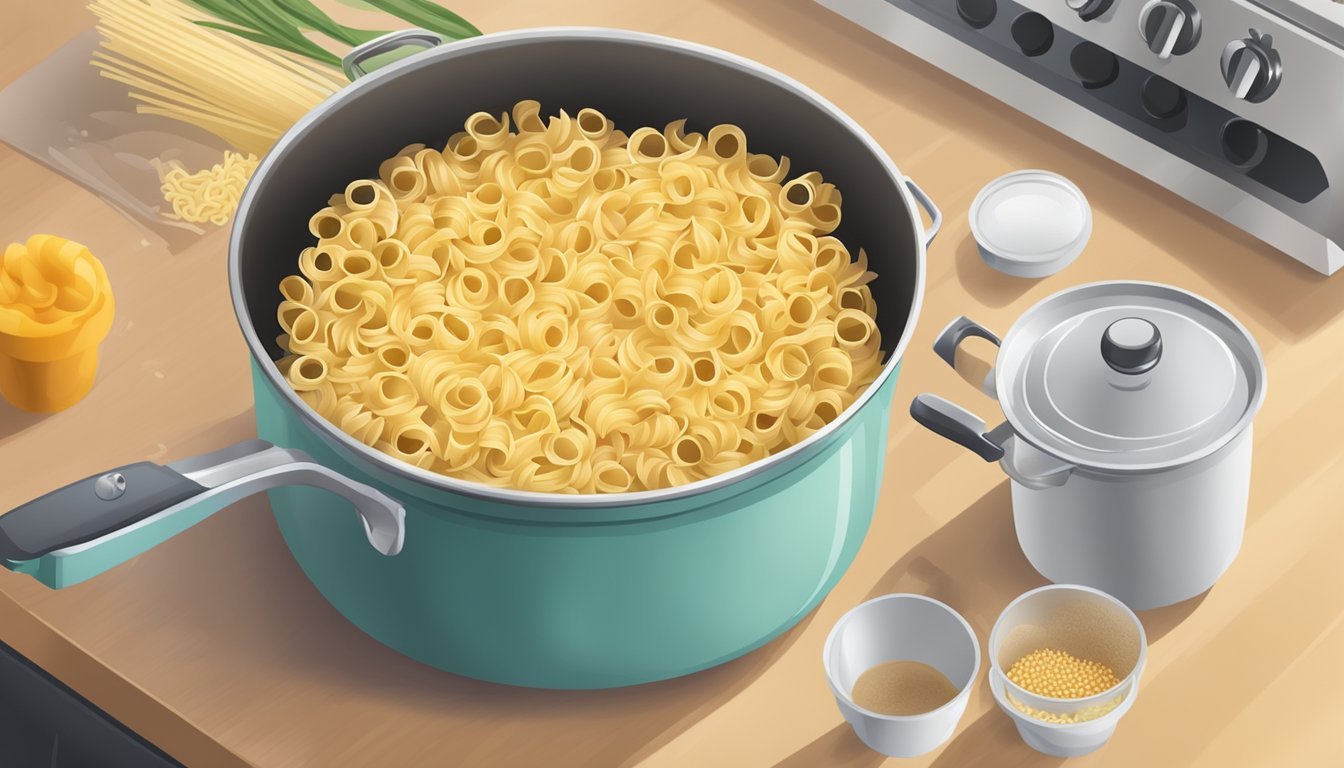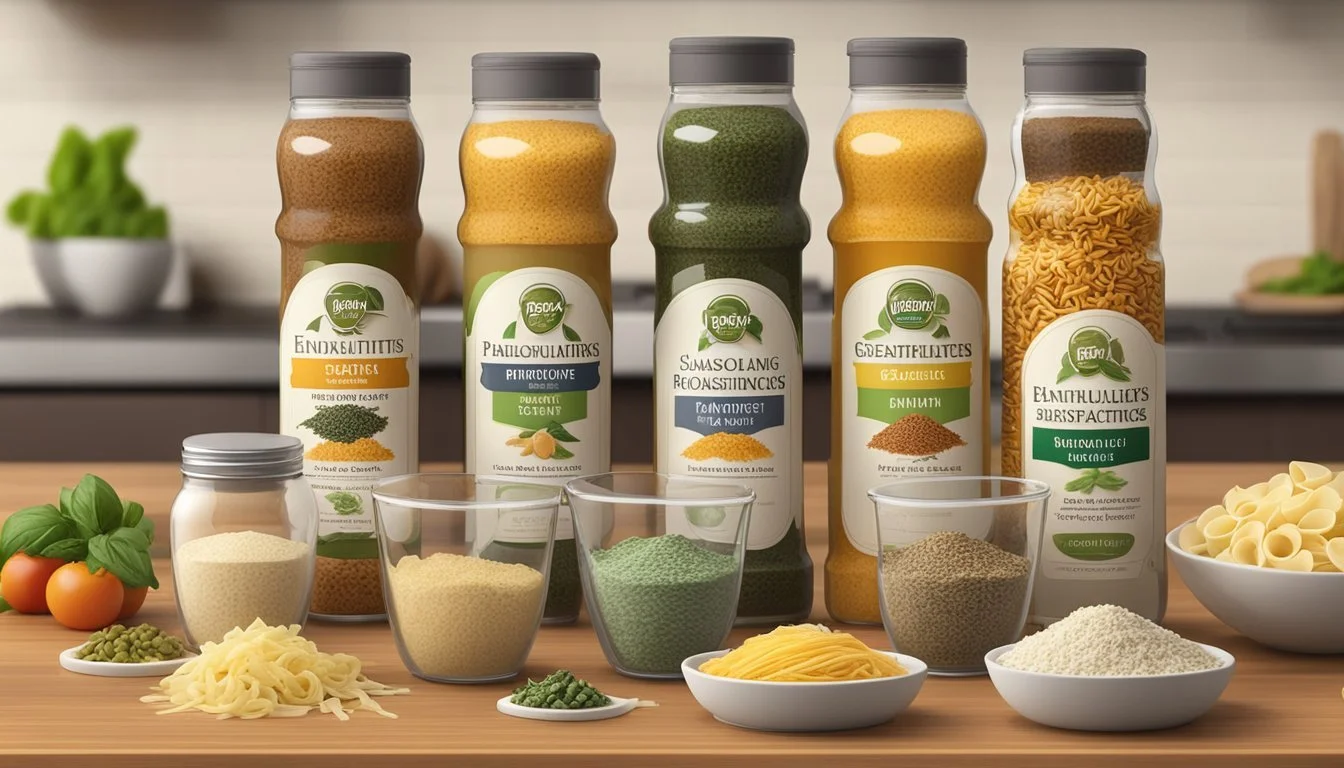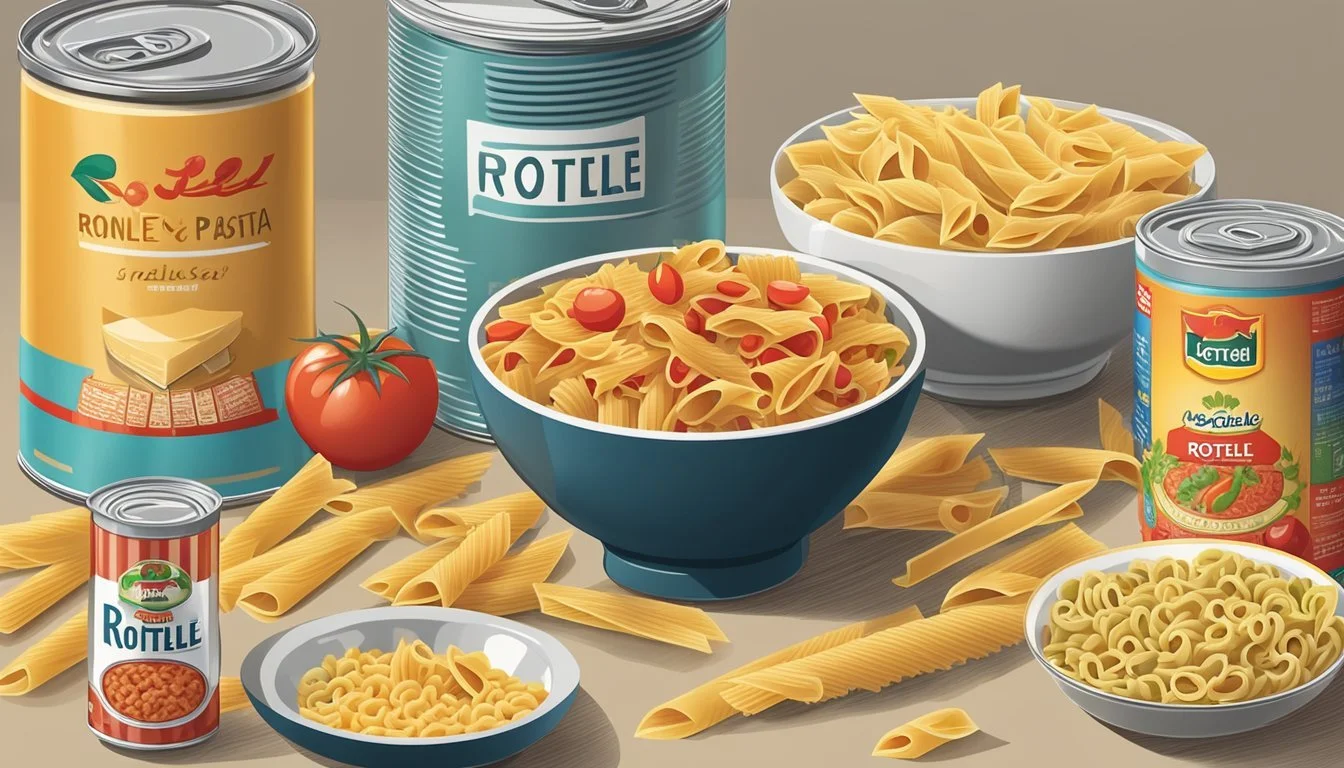Rotelle Pasta Substitutes
Top Alternatives for Your Favorite Dishes
Rotelle pasta (What wine goes well with pasta?), characterized by its wheel-like shape, echoes the playful aesthetic of a child's wagon but maintains a position in the kitchen for its practical use. Its unique form allows it to trap and hold sauces and fine ingredients, making it an ideal choice for a variety of dishes, from robust pasta salads to hearty soups. However, there are times when this distinctive pasta isn't available, and cooks must look for suitable alternatives that mimic its structural integrity and ability to capture flavor.
There is a number of pasta shapes that can stand in as substitutes for rotelle, ensuring that a dish retains textural interest and functionality. For example, fusilli and rotini both possess helical shapes, which are adept at securing sauces in their grooves, similar to rotelle. Their spiral forms, larger surface area, and ridges make them an excellent choice for almost any recipe calling for rotelle. These alternatives maintain the essence of the original pasta dish while introducing their own subtle variations in texture and bite.
In the quest for an appropriate substitute, one might also consider larger pasta forms that offer similar pockets for sauce and ingredients. Shells of various sizes can become a good match for heavier preparations or fillings, while smaller options like orzo or ditalini might be suited for soups where rotelle is typically used. The choice of pasta substitute ultimately depends on the specific qualities that are most critical for the dish being prepared, such as size, shape, and surface texture.
Understanding Rotelle Pasta
Rotelle pasta is a distinctive shape of pasta that resembles small wagon wheels or cartwheels. Its unique design includes ridges with spokes radiating from a central hub. This shape is not just for aesthetic appeal; it serves a practical purpose too. The spokes and holes of Rotelle pasta trap and hold sauces well, which enhances the texture and flavor experience of a pasta dish.
The texture of Rotelle is firm and provides a satisfying bite when cooked properly to al dente. Because it holds up to a variety of sauces and ingredients, this type of pasta is versatile in recipe applications. It adds a playful element to a dish while ensuring that every forkful is loaded with flavor and sauce.
Regarding flavor, Rotelle pasta itself has a subtle taste, making it an excellent backdrop for bold ingredients. The neutral flavor profile means that it pairs well with both light and hearty sauces. It is commonly used in pasta salads, casseroles (What wine goes well with casseroles?), and soups.
Here's a brief overview of Rotelle pasta's characteristics:
Attribute Description Shape Wagon wheels with ridges and central holes Texture Firm, holds sauces well Flavor Neutral, versatile Common Uses Pasta salads, casseroles, soups
Chefs appreciate Rotelle for its ability to turn a simple pasta dish into something that stands out visually and texturally. A well-prepared Rotelle pasta dish delivers both aesthetic appeal and a full-bodied eating experience, satisfying pasta lovers who seek dimension in their meals.
Reasons for Substituting Rotelle Pasta
When a recipe calls for Rotelle Pasta, one might need to find an alternative due to various constraints or preferences. These can range from dietary restrictions and availability issues to specific flavor profiles and textural preferences that a substitute might better address.
Dietary Restrictions
Individuals with gluten intolerance or allergies often seek substitute pasta made from rice, quinoa, or other gluten-free grains that emulate Rotelle's shape and texture. The challenge is to find an alternative that maintains a similar bite and can hold onto sauces well.
Availability Issues
Rotelle Pasta might not always be readily available in all regions or stores. In such instances, cooks may opt for more common pasta shapes like fusilli or rotini, which are widely stocked and offer a similar spiral structure, making them excellent substitutes in both salads and pasta dishes (What wine goes well with pasta dishes?).
Flavor Profiles and Textural Preferences
The distinct spiral shape of Rotelle Pasta traps sauces and small ingredients, enhancing the flavor with each bite. For those seeking a different texture or a twist in flavor, the following alternatives prove suitable:
Fusilli: It's slightly different in shape but similar in its ability to hold sauces.
Rotini: Comparably holds onto chunky ingredients and sauces, albeit with a shorter cooking time.
Cooks might also tailor their pasta choice to the recipe, either highlighting the sauce through a thinner pasta or using a sturdier substitute for heavier, robust sauces.
Best Substitutes for Rotelle Pasta
Rotelle pasta is known for its wheel-like shape and ability to hold onto sauces and add texture in soups and casseroles. When one cannot find rotelle, several alternatives match its versatility and culinary function.
Other Pasta Shapes
Rotelle pasta has distinctive ridges and a fun shape that make it ideal for catching sauces. When seeking similar functionality, pasta shapes such as fusilli and rotini serve as excellent substitutes; they offer a comparable ability to latch onto sauces due to their spirals and ridges. Farfalle, or bow-tie pasta, also provides an appealing visual and textural substitute in both salads and saucy dishes.
Gluten-Free Alternatives
For those with gluten sensitivities, substitutes must maintain the satisfaction provided by traditional rotelle's texture. Gluten-free options such as corn pasta and rice pasta come in various shapes that closely mimic the original. Cooks should note that these gluten-free pastas often require careful attention during cooking to avoid a mushy texture.
Grain-Based Options
Grain-based substitutes such as quinoa, farro, and barley are not pasta per se, but they offer a hearty texture and are excellent in soups and casseroles. When used in recipes as a substitute, these grains contribute a nutty flavor and chew appealing to those who enjoy a substantial bite. They are particularly fitting in dishes that demand robust ingredients to stand up to hearty sauces or broths.
Rotel Tomato Substitute Recommendations
When looking for a Rotel Tomato substitute, one should consider both the texture and flavor profile. Rotel Tomatoes are known for their zesty, spicy kick which can be replicated through various means.
Canned Tomato Alternatives
Canned tomatoes offer convenience and can serve as a Rotel Tomato substitute. A can of diced tomatoes mixed with chopped green chilies makes for a quick equivalent. For added heat, one can incorporate canned diced green chiles:
Mild: Use regular canned diced tomatoes.
Spicy: Add a teaspoon of chili powder or minced jalapeños.
Fresh Tomato Concoctions
Fresh tomato concoctions present a flavorful alternative to Rotel Tomatoes. Combine fresh diced tomatoes with fresh chopped chilies, adjusting the amounts to match desired levels of spice and zestiness. For a balanced flavor, consider:
A mix of halved cherry tomatoes and plum tomatoes for varied texture.
Season with cilantro and lime juice for a homemade Rotel flair.
Homemade Rotel Recipes
Creating Homemade Rotel provides control over the spice and ingredients. The base consists of diced tomatoes combined with green chilies. Here's a simple recipe:
Mix together equal parts diced tomatoes and green chilies.
Season with salt, garlic, cilantro, and lime to taste.
This homemade Rotel mixture can be stored in the fridge.
Commercial Rotel Substitutes
For a store-bought Rotel substitute, look for products with a similar flavor profile and texture:
Tomato Sauce: Offers a smoother texture but can mimic Rotel when mixed with chilies.
Salsa: Choose a zesty or spicy salsa to approximate the chunky texture of Rotel.
Flavor Enhancers and Seasonings
The right selection of flavor enhancers and seasonings can elevate a simple dish of Rotelle pasta to a culinary delight. Using a combination of herbs, spices, and cheeses, one can tailor the flavor profile to suit individual tastes or complement specific cuisines.
Herbs and Spices
Herbs and spices are essential for adding depth and complexity to Rotelle pasta dishes. A blend of dried oregano and fresh cilantro can impart a herbaceous and slightly citrusy note, perfect for a Mexican-inspired pasta salad. For heat, red pepper flakes provide a consistent, fiery kick, while jalapeños or habanero chilies offer a sharp, distinctive heat. Garlic and black pepper are staples that can be used to build a base flavor, catering to most palates.
Citrus and Acids
A splash of lemon juice or lime juice can instantly brighten a dish, cutting through richness and providing a refreshing zing. Acidic components balance the flavors, especially in pasta dishes that might include creamy or cheesy elements. They should be added judiciously to complement, not overpower, the dish.
Cheese Varieties
Cheese adds both flavor and texture to Rotelle pasta. Parmesan cheese, with its nutty and salty taste, often serves as a final touch, grated over pasta to round off the flavors. Alternatively, one can integrate bold cheeses into the sauce; for example, a strong, aged cheddar can introduce a depth of flavor that melds well with the robustness of herbs and the punch of spices.
Recipe Adaptations
In recipe modifications, the focus centers on balance and flavor continuity when substituting ingredients, particularly concerning Rotelle pasta and its common tomato-based pairings. Utilizing effective substitutes can maintain the dish's integrity across various cuisines.
Tomato-Based Dishes
For dishes centered around tomatoes such as marinara or pizza sauce, one can replace fresh tomatoes with canned tomato puree to achieve a smooth consistency. In instances where Rotel is a component:
Pizza: A 1:1 substitution with tomato puree maintains the sauce's body without added spice.
Marinara Sauce: Incorporate diced canned tomatoes for a chunkier texture, or use tomato puree for a silkier sauce.
Tex-Mex Cuisine
Tex-Mex recipes often call for a combination of tomatoes, chilies, and spices. When Rotel is unavailable:
Enchilada Sauce: Use a mix of tomato sauce and chopped green chilies to replicate Rotel's flavor profile.
Queso and Tacos: Blend tomato puree with a dash of cayenne or jalapeño for a comparable kick.
International Cuisine Variations
For a global twist on pasta dishes:
Italian Pasta Sauce: Opt for sun-dried tomatoes or paste for depth and richness.
Asian Noodle Soups: Substitute rice noodles or shirataki noodles for pasta, maintaining a lightweight texture.
Adjusting these elements according to the cuisine ensures the dish’s intended flavors are honored while accommodating dietary preferences and availability of ingredients.
Final Thoughts on Rotelle Pasta and Rotel Substitutes
When exploring the culinary versatility of Rotelle Pasta, one appreciates its unique wheel-like shape that holds onto sauces and complements a variety of recipes. If the pantry is lacking Rotelle Pasta, a confident cook can substitute it with similarly shaped pastas such as fusilli or farfalle. The goal is to match the cooking time and texture to ensure that the substitute harmonizes with the intended dish.
For the vibrant condiment known as Rotel, an array of substitutes can save a recipe when this canned mixture of tomatoes and green chilies is unavailable. Rotel Substitutes should maintain the balance between acidity and heat. Common staples such as diced tomatoes paired with fresh or canned green chilies can suffice. Remember to adjust the spice level to match the Rotel’s zesty profile.
Rotelle Pasta Substitutes:
Fusilli: Similar spiral shape with an excellent sauce hold.
Farfalle: Bow-tie structure offering a delightful bite.
Rotel Substitutes:
Diced Tomatoes + Green Chilies: Customizable heat with familiar texture.
Tomato Puree: Smooth consistency, ideal for soups and sauces where chunks are less desired.
In the cooking journey, the discovery of appropriate substitutes not only showcases a cook's knowledge but also their adaptability. One should proceed with confidence when the original ingredients are not at hand, as there are numerous alternatives waiting to be implemented in the next culinary creation.








